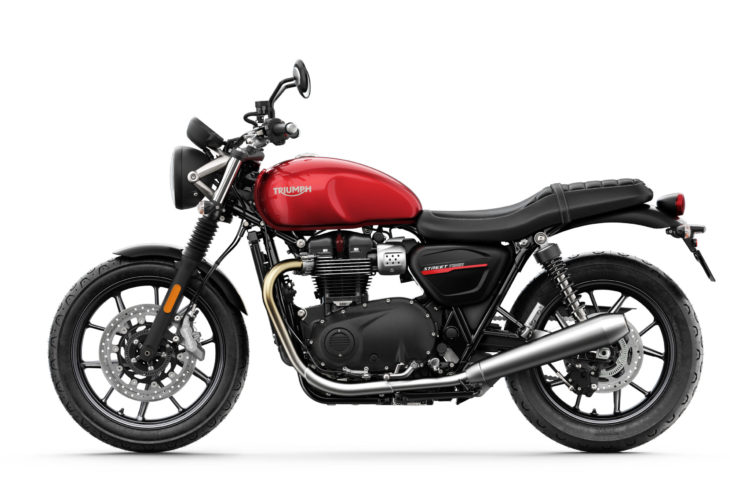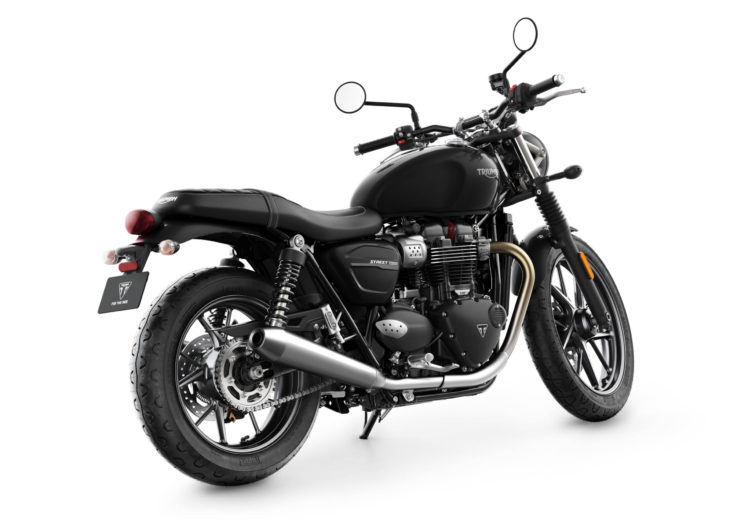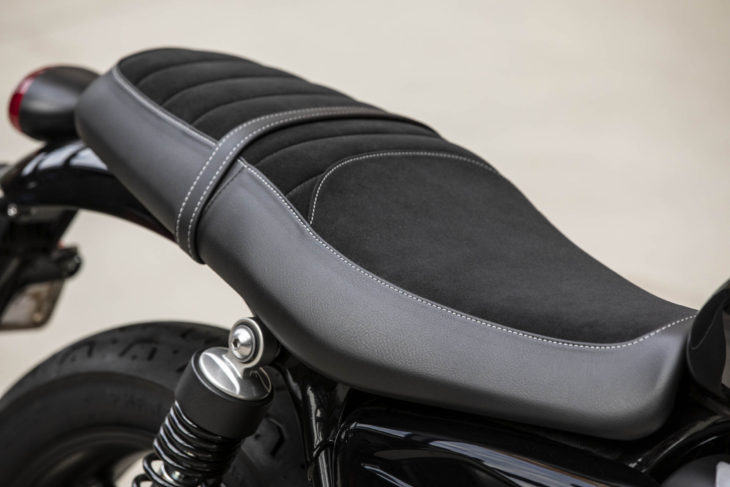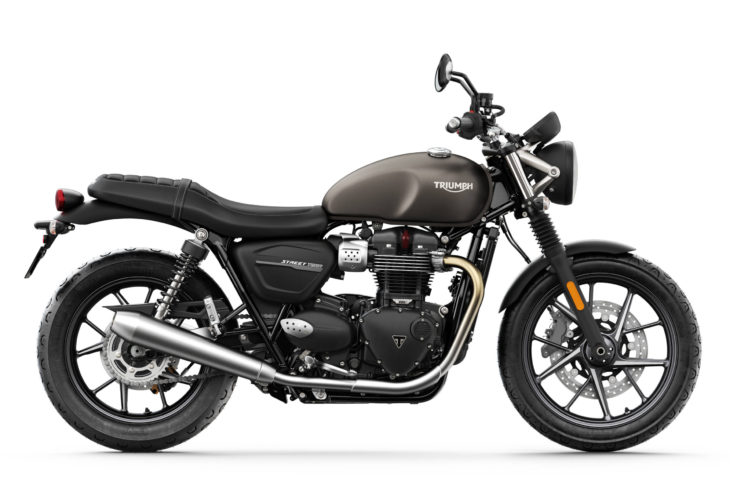Like its sibling, the Street Scrambler, Triumph’s 2019 Street Twin was announced earlier today with an 18% bump in peak horsepower (up to 65 HP) from its 900cc parallel twin, a new Brembo front brake and cartridge forks.
According to Triumph, the 2019 model also gets “first-in-class technology” in the form of switchable riding modes, ABS, traction control and other features. Here is Triumph’s summary of the new model:
For Today’s Originals
Representing a major step forward for Triumph’s most successful modern classic, the new 2019 Street Twin now brings a significant step up in power, a higher specification of equipment, even more rider comfort and first-in-class technology. Launched in 2016 the Street Twin is the most contemporary model in Triumph’s Bonneville line-up and has become the single biggest selling modern classic. This success has come thanks to its beautiful custom looks, accessible and confidence inspiring ride, and thrilling high-torque engine.
Available: January 2019
Triumph’s best-selling modern classic
- More than 90% of Street Twins sold to date have been fitted with Triumph accessories
- Chosen by the widest age range of riders and many people new to motorcycling
- The starting point for many pro-build customs
More power and performance
- Significant power increase, up by 10Hp to 65Hp, 18% more peak power than before
- Higher revving engine, with a red line now 500rpm higher than the previous generation
- High 59 Ft-lbs torque output
- Unmistakable British twin sound
Higher specification for improved rider control and comfort
- New Brembo 4-piston front brake caliper, enhancing braking performance
- New higher-specification cartridge front forks for a more comfortable ride
- Improved rider ergonomics for enhanced riding experience
- Enhanced rider and pillion seat comfort
New first-in-class technology
- New Road and Rain riding modes
- New accessory option TPMS (Tire Pressure Monitoring System) capability
- ABS and switchable traction control
- Torque-assist clutch
- LED rear light
- Immobilizer and USB power socket
More contemporary custom style
- New cast aluminum multi-spoke wheels with machined detailing
- New contemporary logo
- New more premium instrument styling
- Improved finish and detailing across the whole bike
Built to personalise
- 140+ custom accessories
- Two new inspiration kits – Urban Ride and Café Custom
See more of MD’s great photography:










OIF A65L… Such excitement with that front brake and it’s sparrow swallowing air scoop. Teaches you to turn with conviction because if you don’t you’ll plow into something. That sewer pipe cum oil tank linking headstock to swingarm makes for a rather stable frame to go with the al dente forks and swingarm. To be honest the forks are not that bad if you get the spring rate and sag right. The back shocks, well, there’s always aftermarket. Amal Mk1, what can I say… Rebuild is a breeze, and get the slides sleeved. All in all it’s staying in the garage while the 2008 BMW K1200gt will be sold Spring 2019. Simplicity has a quality all its own.
I still don’t like tank seams. I don’t get it. The old Triumphs didn’t have tank seams. Why do the “retro” ones have tank seams?
Because Triumph is too cheap to do it right? Same with the tubed wheels on some models. Too friggen’ cheap. What’s next, orange peel paint jobs?
Tank seams on Triumphs are not unprecedented. Throughout the 50’s and 60’s and into the 70’s the seam was down the center of the tank and often covered with a thin chrome strip. The seam welds have simply been moved to a different location to accommodate a change in manufacturing procedure.
The 900s had restrictor cams according to this bloke.
https://youtu.be/hRk6x_u3mBI
His company made some normal cams and picked up 10 hp. So…no magic here and no tradeoffs. Just because the torque peak shifts up doesn’t have to mean less torque at the low revs if the original motor had a testosterone deficit.
The only thing these bikes have going for ’em is the use of cast wheels with tubeless tires. Otherwise, Pffffft!
Tiny tanked with a single disc up front and did I mention the tiny tank? Those that “defend” the use of a puny fuel cell doubtless do so because they’re the motorcycling equivalent of the “Social JustUs Warrior™”, i.e. “every bike is special”.
Of course they don’t buy anything, least of all a bike that they “feeeeeel” so close to. So much so that they just “love it!”.
The bikes look nice but looks ain’t everything. All riding is a form of touring. Looks won’t get you to the next town. Fortunately as the fuel is used the bike gets lighter making it easier to push to the next town.
Genius Triumph engineering, there lads!
The bike has a 3.2 gallon tank and is rated at 60 mpg. If you pull out your trusty slide rule you’ll come up with a range of 192 miles. Figure a safe range of 150 miles and that’s more than 2 hours at highway speed. How far do you want to ride a bike like this between rest stops?
My old ’91 GS500 had a similar sized tank, and got similar mileage, so I can’t (and won’t) complain about the tank size. 2 hours of riding at freeway speeds with zero wind protection was enough anyway.
What I will complain about is the power output. The old GS500’s engine was about 1/2 the size (487cc, or there about), and had about 50 hp. How does this engine have only 65hp? With fuel injection and 28 years of technology improvements? Seems a bit low on either power, or on fuel efficiency.
Another example is the BMW F650/700/800 bikes with their 800cc parallel twins (I also owned one). They get 60mpg on the highway, and have more than 65hp as well.
The tradeoffs here don’t seem to make sense.
There are people who actually prefer a little fart of power at the bottom of the rev range in lieu of a nice, broad power band. We don’t understand them. They don’t understand us. That’s just the way it is.
The GS500 had 40 rear wheel horsepower (50 was mfg rated at crankshaft). I used to have a GS450 and the best MPG I ever got was 50. So, 28 years of technology yields more power, better mileage, far better drivability and handling… Keep in mind that the Street Twin is aimed toward females and beginners, not to take anything away from it. Those riders want smooth, consistent power. If you want more beans get a Street Triple. The new 765 model is awesome and is rated at 112 HP!
“So, 28 years of technology yields more power, better mileage, far better drivability”
No, twice the displacement tuned for go-kart power (relatively speaking) is how Triumph achieved that.
“The starting point for many pro-build customs.”
I think they mean bro-build customs.
Excellent wording, sir!
Problem with this Triumph if anyone has owned one is that vibration sits in right @ 70 mph and the seat als0 digs into the inner thighs!!Not a fan of this one
Never pass on a bike because of the seat, just get a Corbin seat.
I agree but its a vibrator at best lol Not a lot of bike for the money
Great improvements. Just depends on price now.
I do hope that the T100 will get the power increase as well…
Every year, Cycle magazine would tout the “new” Triumph Bonneville. More power, more speed. Every year, 40 horsepower. Then the Honda “Super Hawk” 305cc came out.
Now, Triumph has more power, more speed.
Me: I want 100 HP and NO vibration.
“Me: I want 100 HP and NO vibration.”
.
Then you don’t want a twin, no matter who makes it.
I have a Ducati XDiavelS. 156 Hp and no vibration anywhere in the powerband. Also have a HD V-rod. 110 HP and no vibration.
Great looking machine, functional beauty!
Going to take a serious look at this. Hopefully the price won’t go up much, otherwise there will be little reason not to step up to the T120.
That seat looks great! And the fuel consumption numbers are impressive too.
I wish Indian would make a bike like this.
A parallel twin? They went down that road starting in the late 40’s, early 50’s. Doubt they’ll go back
It’s always a ‘Blast’ to see America make something besides a V-twin.
Starting in 2019 they’ll be selling a bike that is better in every way than this. These are a hangover from a period that “retro” meant detuned soft machines. Kawasaki, ducati, and soon Indian, are putting an end to that.
Nowhere in the article or the headline does MD mention the “size” of this bike.
Come on MD. You can do better.
http://www.motorcycledaily.com/2015/12/new-triumph-street-twin-specs-and-bonnevillle-range-pricing-announced/ – he did in the first article
Very nice unlike the scrambler.
I agree regarding Scrambler; it looks bit ‘squeaky’ in visual sense.
Great bike. Looks almost perfect for the genre to me.
HD, this is your target.
So now it has something like the power that it should have had to start with – I loved the look, but 55 HP from a 900 is just sad (H-D like). Also surprised to learn it just got cartridge forks, which presumably means until now it had damper rod forks, which should have been consigned to the dustbin of history 20 years ago.
55 HP is plenty for new riders, in fact, way more than enough, which is a large market for these bikes. My TU250 had 18 HP and that was fine most of the time. – one can always bike a street triple for more specs – why do we always want race components and power on retro bikes, thus driving up prices? – people actually have to pay for these bikes with regular sub 50k a year salaries.
There aren’t any race components on this bike. Cartridges just (usually) work much better than damper rods. Good brakes work better than crappy ones. Those two items can offer a much improved riding experience that even new riders would be able to discern (if done well) at a very marginal increase in price, if any. And 65 HP on a bike this heavy is still plenty manageable for new riders.
The bikes were already a little too expensive to feel as crude as they did in the suspension and braking department. This is a worthwhile change, IMO. And they definitely needed the power boost. Hopefully that power is also distributed more broadly through the rev range.
Moreover, Triumph would rather have these models be accessible to -young- people, not old farts that can afford to spend $15,000 on a naked retro bike. That young customer could buy 2,3, 10 more bikes in the future if they get hooked on the brand. Motorcycle manufacturers need a way forward to continued profits.
As stated, 55HP (50-52 at the wheel by most dynos) is more than enough for a street bike like this. Power delivery is bottom-heavy, and the bike performs well.
Hell, if this bike now does closer to 60 at the wheel, adds cartridge forks, and a brake upgrade as well, if the price doesn’t increase too much, that’s a pretty solid group of upgrades!
Apparently Triumph has conceded this argument to those who think it should have had more power, like me. New riders, as in inexperienced, shouldn’t be riding a bike like this, anyway. And once they graduate to something like this, there’s requirement that they actually use all that power. OTOH, it might just come in handy when passing, for example. I still think 55 HP from 900 cc is pretty pathetic specific HP – in fact I’ve owned multiple cars, not performance models, that were better than that in terms of HP/litre.
What kind of bike to you firmly believe all new/inexperienced riders should be riding? I learned to ride on a Honda VF500F (claimed 86 HP) at 16 years old in the West Virginia hills and hollers with some basic direction from my friend that owned it. I ended up buying it soon after so he could get a Hurricane. I didn’t kill myself on it, with its more powerful engine and aggressive ergos.
.
I can remember when certain cars didn’t even have 55 HP out of 1500cc. And they were liquid cooled. Yet they were able to push a 2000 lb vehicle plus passengers up to highway speeds and go all over the place.
Small, light ones. But if they’re going to dive right into larger bikes, they’ll just have to learn how to use that power. I can’t see any reason anyway that adding some HP mostly to the top of the RPM range should make the bike any more or less useful for a beginner.
Yes, I remember when cars were gutless, too. That time was 30 years ago. My ’96 Nissan Sentra was good for 115 HP from 1.6 litres. That’s about 72 HP/liter, or about 72 HP/l. Or about the same as the updated Street Twin. And that’s a cheap car from 20 years ago and hardly a performance model.
Anyway, point being, I see no downside to Triumph adding some of the power back into this model that it should have had in the first place.
HP/Liter is not a worthwhile metric for a bike that doesn’t pretend to be a high-performance bike. If they wanted to make more hp, of course they could, but that would sacrifice torque at low rpm and efficiency (ever wonder why 100hp 600’s only get 35mpg?).
60hp is plenty for a bike like this and I don’t imagine most of it’s buyers will even ask the salesperson how much it makes. Need more? You’re shopping in the wrong aisle, street triple is over there…
55 hp from 900 is just fine for a street bike especially with the power and torque low in the rev range.
Once upon a time I was young and had a 1992 Yamaha FJ1200, 1996 Ninja ZX-7RR, and 1996 Ninja 500. Guess which on got the most use? The “little” 500 with “only” 50hp / 30 lb-ft. It made a great commuter bike, had plenty of power for road riding AND returned excellent fuel mileage. It was also nice to open up the throttle every once and a while on a twisty road. The other two bikes were quickly into “go to jail” speeds at even 1/2 throttle.
The 2016-2018 Street Twin had more power and much more torque than my old Ninja 500. More isn’t always better sometimes enough is just right.
Better suspension and brakes are always welcome.
You make my point. Late 80s 500cc liquid-cooled parallel twin produced 50 HP. New 900cc liquid-cooled parallel twin producing 55 HP? Seems neutered to me. It’s not like you have to use all the power, but at 900cc and for this price, it’s not unreasonable (IMO) to expect more, which they have now delivered.
Why… oh, why… are people on public comment boards like this SOOOOO obsessed with these peak HP numbers? Especially on bikes that are EXTREMELY biased towards non-veteran riders?
Do this : Find an actual dynamometer run from your old EX500 or something. Overlay the plot on top of a plot for this engine. What you’ll see is a HUGE disparity in “power under the curve”. A 500cc parallel twin is going to make less than half the power at 4000rpm. Probably only 2/3 of the power at 6000rpm. Eventually, at 11,000rpm or so, the 500 will finally make the peak HP that the 900 made at 7000rpm or so.
THAT is the difference here. This engine is hardly neutered. It’s heavily calibrated towards delivering ALL of its power – right now – low in the RPM range, and making it easy to operate at surface-street speeds.
For an even more obvious example, do the same with a V-Star 950 engine. Even less peak HP, but even more lb-ft at low, low rpm. A peak HP number tells you almost nothing about what the bike will be like under normal conditions…
Thank you.
If you’re combing through dyno sheets and looking at this bike, you’re probably shopping in the wrong aisle because the peak HP number doesn’t have much bearing on the ride experience they’re delivering here.
Dyno runs don’t really tell you much either as they ignore gearing, which ultimately dictates how much torque the bike actually makes at the wheel for a given speed. I digress.
But regardless, your point stands: it is a comparison of two very different engines with very different design goals. Triumph could have easily made a 90 hp twin to power these Bonnie’s had they wanted to.
They just decided that their customers wanted something cruiserish out of the engines. And I guess those customers got back to Triumph and said, “You’ve gone to bloody far with this torque tune. Mo’ powwa please!”
Like I say, apparently Triumph disagrees with you. And also, apparently, it is possible to make a bike with this sort of torque characteristics without totally killing its top-end power (at least quite so much). 65 HP from a 900 cc bike is hardly a high-revving bike with no torque.
Can they eventually integrate that egg shaped cover on RH side with the rest; a minor point and bit picky, I realize that. The power for volume improvement is overdue. Otherwise it looks ok; I checked previous model at bike show already.
The only option I’d call for would be taller/thicker seat (I am 6ft tall and do not need that super low seat).
The taller/thicker seats from the T100 and T120 are interchangeable, and then there’s always the aftermarket.
Not nearly as bad as you felt when my 1964 Honda 305cc Superhawk out performed that Triumph in every way, lasted 10 times as long and didn’t break down:)
My last Triumph was a 2012 Rocket 3 Roadster (OMG) and I had a new 2010 Triumph Scrambler and loved it but although it had a lot of torque and was fun to ride in a city or rural setting, it was SLOW after about 70 mph and got about the same fuel mileage (40 mpg) as my Rocket 3.
I like this new 2019 bike better and if it sounds like even the stock ‘Street Twin,’ it may be my next bike:)
Simply beautiful. Hard to find anything that looks out of place. Centerstand is only thing missing.
“Unmistakable British twin sound”
It’s a 270 crank.
Up until a few years ago, most Triumph Twins were 360.
That disingenuous claim bugs me too. The air cooled Hinckley twins, depending on the model, could have 360 or 270 degree cranks, but the liquid cooled models are all 270. My 2008 Bonneville with 360 degree crank has the true “unmistakable British twin sound” and I’m keeping it that way.
A much needed improvement for this model line. Price per performance was severely lacking before. That being said, if I had bought one of the earlier Street Twins, etc., I would be pretty PO’ed right now.
PO’d about buying an earlier Street Twin? Back in the early 60’s I bought a Triumph twin with separate engine and transmission, kickstarter only, drum brakes, and a magneto and generator. How do you think I feel?
Hopefully Triumph didn’t shift the torque peak higher chasing specs. The flat torque trace and peak torque at 3250 RPM are what makes the Street Twin such an enjoyable STREET bike.
I personally hope they spread the power out across the rev range more. The current power plant makes for an enjoyably farm implement maybe, but a relatively dull street bike in my opinion.
Triumph has never chased spec sheets with their retro line, so I doubt they are starting now. This is most likely the result of customer feedback, perhaps especially those customers they may have lost or could potentially lose to bikes like the Ducati Scrambler.
Seriously. It feels like diesel power. Quick bursts from 2000-4000. Nothing much after that!
There’s no free lunch: in gaining the additional hp (to please spec sheet riders), the torque peak has risen – by about 500 rpm, I believe.
Lunch wasn’t free but they probably didn’t need to move the torque up the range to achieve more power. They could have done some or all of the following;
increase the compression ratio,
create smoother, more optimized (less restrictive) intake and exhaust tracts,
improve combustion efficiency with a new head design and unshrouded valves,
or better atomize the fuel in the intake with refined injectors and higher pressure coupled with a more accurate closed loop feedback.
Please get in touch with Triumph immediately – their team of ignorant engineers obviously need your advice.
Interesting response… You were the one that suggested they only knew how to increase power by increasing rpm! I suggested they were smart enough to get more power through additional engineering refinement – a resource they already have.
I guess my point is that if I had just plunked down for a 2018 to find out that these needed changes were coming, I would be none too happy. I own a 2006 Thruxton that makes more power than either Street Twin version.
I hear ya’. I’m thinking the riders that bought a 2019 are going to be regretting that they didn’t wait for the 20XX models. Every new model year will have more to offer, but you can’t sit on your hands forever. That said, I’ve been tempted by the new liquid cooled models, but in reality my 2008 Bonnie has all I need.
That’s why Triumph was doing 0% financing earlier this year. A clear sign to “watch out” in my opinion.